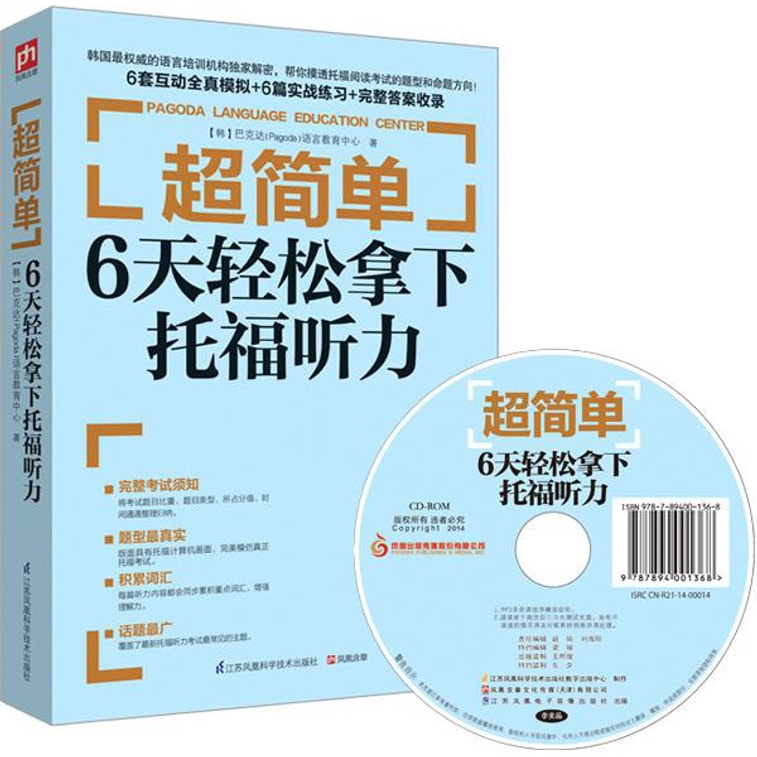Introduction to TOEFL iBT
TOEFL iBT (internet-based TOEFL) is designed to measure how well non-native speakers of English read, listen, speak, and write in English. The test has four sections:reading, listening, speaking,and writing. Each section of the test is worth 30 points and the highest possible score on the iBT is 120 points (30 points x 4 sections). Most questions are worth 1 point each, but some of thequestions in each section are worth more than 2 points.
For more information, visit the ETS website (www.ets.org).
Listening Section
(1) About the listening material
In the listening section, test takers are asked to listen to 4 or 6 lectures and 2 or 3 conversations. The length of each material varies from 500 to 800 in words, or 3 to 5 minutes in listening time.
There are two major types of listening material covering a wide range of topics that students need to listen in academic environment:
Lecture: a talk given by a professor or a discussion withstudents on an academic subject in the classroom setting
Conversation: a student talking to a professor, teachingassistant, school staff or employee about a situation related tostudent life
All material is recorded in natural spoken English from North America and other English-speaking parts of the world.
(2) About the questions
After listening to each material, several questions follow to test the test takers' ability in the following areas:
Number of Passages
6 60 min
9 90 min
4 Lectures
2 Conversations
6 Lectures
3 Conversations
Types of Material Test Time
Basic Comprehension: ability to understand the main topic and idea of the material and detail information
Connecting Information: ability to understand organization of the material, connect content and make inferences
Pragmatic Understanding: ability to understand the function of what is said and recognize the speaker's attitude
In order to test these areas, there are six major types of questions asked in the TOEFL iBT listening section.
Question Type
Main topic / idea
Basic Comprehension
Connecting Information
Pragmatic Understanding
Explanation
Asks about the overall topic or the central
idea of the material
Related Unit
Unit 1
Supporting /
Specific Details
Asks about specific information that are important points within the material Unit 2
Organization Asks about the overall structure and flow of the material Unit 3
Content Asks about the relationship and reasoning of specific information within the material Unit 4
Function Asks about the purpose or meaning of specific information or phrases Unit 5
Stance and Attitude
Asks about the attitude or implied meanings of the speaker Unit 6
Winning TOEFL Listening
It has 6 units, and each unit includes 6 lectures and 3 conversations in various lengths. This book is designed for students who are beginners in academic listening. Therefore, the level of difficulty and the length of the listening material have been modified from the original materials seen on the actual TOEFL.
Each unit of this book deals with a specific academic topic and situation that appear LECTURE TOPICS CONVERSATION TOPICS
Unit 1 Natural Science Class Activities and Registration
Unit 2 History School Admission
Unit 3 Applied Science Student Housings
Unit 4 Education and Language Student Jobs
Unit 5 Nature and Society Student Activities
Unit 6 Arts and Culture School Policies and Facilities
frequently on the TOEFL:
Each unit consists of:
Introduction Practice I, II Test 1, 2, 3 Listening Helper
Each section has the following subsections.
Introduction
(1) Key Expressions
Key Expressions are provided to help students become familiar with frequently used expressions in academic settings. Each unit carries different set of expressions that may be used with specific intentions. Students should pay attention to these
expressions as signals for more important information while they are listening.
(2) Target TOEFL iBT Questions
This part is to prepare students with frequently asked question types in the TOEFL iBT listening test. Students are encouraged to listen for type of information that is more likely to appear in the questions. Each unit focuses on the following TOEFL iBT question types:
Unit 1 Main Idea and Topic Questions
Unit 2 Specific Detail Questions
Unit 3 Organization Questions
Unit 4 Content Questions
Unit 5 Function Questions
Unit 6 Attitude Questions
Practice Ⅰ, Ⅱ
The main purpose of this section is to lead students to listen to short passages (170 words in average) and find answers for target questions. Additional exercises with specific tasks follow to strengthen students' skills for keyword listening and summarization.
(1) Warm Up
This part is provided as a pre-listening exercise. Students are asked to choose one of the words inside the bracket to complete each sentence (reflecting the topic of the following listening material). The purpose of this exercise is to familiarize students with the content of the lectures or discussions in the practice section.
(2) Part I: Practice 1, 2, 3 - With dictation exercises
In this part, students are asked to answer one target question for each listening material. Then the following dictation exercises ask students to listen again to fill in the blanks in the script provided. These exercises are designed to help students practice listening skills on linking sounds and sound confusions.
(3) Part II: Practice 4, 5, 6 - With summary exercises
In this part, students are asked to answer 2-3 questions including target questions for each listening material. Then the following summary exercises ask students to listen again to complete the summary notes. These exercises are designed to lead students to understand the overall flow of the material and be able to extract its key information.
(4) Vocabulary
Each practice question is provided with the list of key vocabulary. This list can be studied before students listen to the material in order to enhance students' understanding. It can also be reviewed afterward in the Listening Helper section.
Test 1, 2, 3
In this section, students are required to listen to longer material (240 words in average) and answer 3-5 questions including each unit's target questions. This section is an opportunity for students to apply their skills acquired from the unit
into more intensive practice.
Listening Helper
This part is provided to help students review and strengthen their knowledge of essential vocabulary. Students are asked to read or listen to each statement and complete it with the correct vocabulary. Each statement and the vocabulary have been taken from the practice section.
Actual Test
At the end of all 6 units, one set of actual test is provided. In this section, there are 6 listening materials (4 academic lectures and 2 conversations) followed by 3-5 questions. Although the lengths and the difficulty of the material have been modified to meet beginner's level, students are encouraged to take this section as an actual test taking opportunity.
































评论{{'('+ commentList.posts_count + ')'}}
分享你的感受,帮助更多用户做出选择。
写评论{{i}}星
{{i}}星
{{ parseInt(commentRatingList[i]) }}%
{{ showTranslate(comment) }}收起
{{ strLimit(comment,800) }}查看全部
Show Original{{ comment.content }}
{{ formatTime(comment.in_dtm) }} 已购买 {{groupData}}
{{ showTranslate(comment) }}收起
{{ strLimit(comment,800) }}查看全部
Show Original{{ comment.content }}
{{ formatTime(comment.in_dtm) }} 已购买 {{groupData}}
暂无符合条件的评论
评论详情
{{commentDetails.user_name}}
{{ showTranslate(commentDetails) }}收起
{{ strLimit(commentDetails,800) }}查看全部
Show Original{{ commentDetails.content }}
{{ formatTime(commentDetails.in_dtm) }} 已购买 {{groupData}}
回复{{'(' + replyList.length + ')'}}
{{ reply.reply_user_name }}回复{{ reply.parent_user_name }}
{{ showTranslate(reply) }}收起
{{ strLimit(reply,800) }}查看全部
Show Original{{ reply.reply_content }}
{{ formatTime(reply.reply_in_dtm) }}
End
请输入评论
举报
取消确认删除该评论吗?
取消